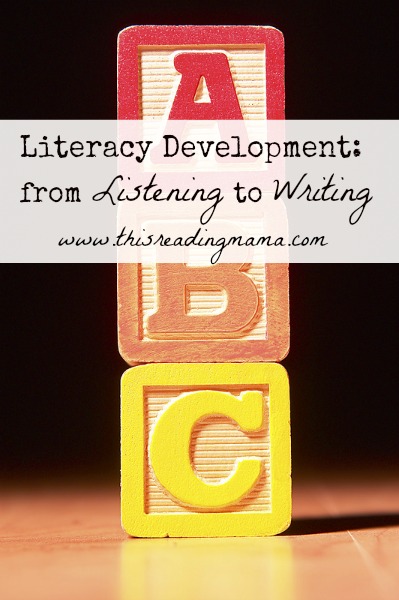Literacy encompasses more than reading and writing. It includes listening, speaking, reading, and writing. I know that I’m not a linguist, but there are a few things I’ve noticed and observed myself about kids and their literacy development.
Literacy Development Typically Develops in this Order:
- Listening. I just had to share what my sweet MBug is doing at 11 months old. She can clap her hands, put her hands up, shake her head when you say, “No way, Jose”, and look out the window when we say, “Where’s the airplane?” (we live near the airport)
- Speaking.
- Reading/Decoding.
- Writing/Spelling.
Not all kids spend the same amount of time in each stage before adding on the next one. ALuv was almost 3 years old before he really started talking, whereas NJoy was speaking in complete sentences at 2 years old.
So, why am I telling you this? Because we need to consider how kids develop with literacy before we try and make them fit into a curriculum that isn’t so considerate.
For example, I recently attended a homeschool conference {that will remain nameless} in which I was introduced to a literacy curriculum {also remain nameless} claiming that kids should be able to spell every word they can read…that reading and spelling development should happen at the same time. Really?!? Maybe I’m just naive and inexperienced, but I’ve yet to find a child who can do that! Actually, I can’t even do that. I can read the word ophthalmologist, but I just had to look it up to spell it for you.
Writing and spelling, in their essence, are much more demanding than reading. A beginning reader may rely heavily on context clues to read words, not necessarily paying attention to much more than the pictures and the first letter in each word. This is not so with writing.
A young speller has to not only think of what he wants to write, but also how to:
- listen for letter sounds in each word (phonemes)
- pick the right letter/letter combination that matches each sound (phonics)
- remember what the letter(s) looks like (visualize)
- form each letter correctly (handwriting)
- remember the exact order in which the letters come to spell some words conventionally (spelling)
- then remember what message he was trying to portray in the first place; so he can start the whole process all over again to spell the next word in his sentence {whew!}
No wonder it may take him ten minutes just to write three words!
Sometimes you just need trust your gut and use your own judgment as a reading mama or teacher. Just because the curriculum (or the school) says it’s supposed to be done a certain way doesn’t mean that every child will fit that mold. And just because an “expert” or “researcher” in the reading field says it, doesn’t mean it’s necessarily developmentally appropriate either.
Stay connected to This Reading Mama so you don’t miss a thing:
- Subscribe by email {get really cool FREEBIES when you do!}
- Google+
~Becky

Excellent post. I think it’s important to understand these stages. I could almost see my children’s brains developing as I spoke to them about anything and everything from the day they were born. I think sometimes when thinking about teaching reading one forgets the stages that need to come before the written word part. As for the spelling–that is one of those “whatever” moments. As you said adults can’t even do that.
Thank you for your kind comment. I think we forget sometimes to be critical readers and learners ourselves and end up doing things just because curricula says that’s what should be done. I know I’ve done that before.
Excellent information and all true, in my opinion. Thank you so much, you explain it so well. Carolyn